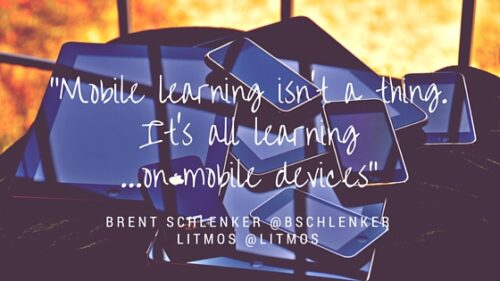The Future of Mobile Devices, Mobile Software, and Mobile Learning

The L&D industry talks a lot about mobile learning. But what about mobile training? With as much as we focus on the learner these days, its equally important to focus on the instruction. Many will argue that you can’t/shouldn’t deliver entire classes on mobile devices. Let’s put aside the notion that “courses” are wrong, and that mobile devices should never be used for delivering them. Let’s consider for a moment the possibilities. What if mobile devices were your only choice…for everything?
How Mobile Devices Impact Training Development
Today the training industry concerns itself too much with making a distinction between desktop eLearning courses and mobile learning. The argument seems to be mostly based on form factor. And for the last 8 years, and maybe the next 3-5, that’s a very real concern. However, looking at the trajectory of innovation in computing I see only one logical future: The elimination of desktops and laptops as we know them today. How does that change conversations like “mobile devices are best for performance support”?
Legacy of Training Development Confines Mobile Devices to Performance Support
Our industry’s legacy carries with it the burden of existing courses, development tools, and processes, invented only for the desktop or “big screen”. Many of those models and processes, originally invented for the 50 year old classroom, were used for early computer based training design and much of what we call elearning courses today. All of which were created before hardware like the touch screen iPhone and tablets were even imagined. And so while both the desktop/laptop and mobile devices exist together it’s easy to confine mobile devices to performance support. But I’m not sure that will always be the case.
Mobile Devices Support Shifting Focus from Learning to Teaching
Everything designed and developed for mobile devices focused more on the learner, and how they would consume the knowledge, than on the instruction. But how much of your training content is currently created on a mobile device? Probably little to none. I would guess that the development tools you’ve purchased to create today’s mobile learning are mainly for the desktop/laptop. But hardware technology is quickly becoming more powerful and more capable than laptops and desktops. And this extra power is being used to manage the production of content like live video streaming, video capture, voice to text transcription, and so much more.
Powerful Creation Tools Enable Everyone as Teachers/Creators
For the training industry that not only means content creation, but live instructor presentation as well. Today it’s not the devices themselves that limit this instructional potential, but the connectivity access and reliability. But that will soon be a thing of the past as well. Mobile devices will then make it possible for everyone to become an instructor, or subject matter expert, of something. Much like musicians can now create and distribute music all from one device, those same devices will act as both learning consumption and training creation/presentation tools. But even if connectivity remains an issue, the newest smart phones are powerful multimedia production tools, putting the power of creation into anyone’s hands.
How Mobile Device Software Innovation Changed the Game
In order to support the mobile hardware of the future there will need to be software. What we call cloud computing today will be the computing of the future.< If you want a preview into what this will look like just take a look at YouTube and Google Chat, or even apps like Periscope, and blab.im. The YouTube site functions seamlessly across all hardware platforms, software systems, and mobile devices. The experience is beautiful and easy to understand. On the iPhone video from any website or app automatically optimizes to play based on the orientation of your phone. Most of what we call eLearning today cannot do that. Consumers will begin to reject this lack of flexibility and ease of use. But this is an industry problem, not a hardware/software problem. We need to adapt and move forward with the technology.
How New Software Impacts Training
Google chat (or Hangouts), Periscope, and blab.im all give us a window into the future of devices as live communication tools. Both planned and spontaneous events are supported. Our industry’s legacy of webinar tools is slowly seeing the change and allowing for presenters to deliver via mobile devices. But is it too little too late? I don’t know. But I do know that in the heat of a “lines down” problem, or other expensive business issue, time is money. And being able to discover a solution and present it to multiple people, around the world, quickly and easily will save businesses a lot of money. Mobile live streaming tools like Periscope and blab.im can do this with just a few clicks almost instantly. And they can record it which makes it available as future training content.
The aftermath of these discoveries is updates to training, so the issue never happens again. And this needs to occur faster than our current models can handle. Mobile devices and the new software on them give training departments a new tool in the trainer’s toolbox. The legacy of mobile learning is in devices as learning consumption tools. Today’s reality, and into the future, is software providing a powerful option to the trainer as well.
Does Mobile Instructional Design Die or Evolve?
Is there a special design model for mobile learning versus traditional eLearning? There shouldn’t be. Maybe right now, today, the two still need to be differentiated. And there are plenty of books to help you do that. But the future holds a different path for training design. Everything mentioned above regarding software and hardware will drive a revolution in training that makes most of what we know as instructional design unnecessary.
Questioning The Validity of Instructional Design
It’s like the success of Khan Academy. It starts as just one guy sharing his knowledge with his family. Then he realizes that friends and others are finding his tutelage helpful. And you know the rest of that story. There are more subject matter experts like Salman Khan than there are instructional designers to help them design their training content. And when they go it alone, they do just fine providing value to many. If ever there was a time to question the validity of instructional design it was 5 years ago.
Employee Empowerment Will Be The New Instructional Design
The new instructional design model, thanks to mobile devices, is collaboration and communication. It’s about everyone creating content, connecting, and sharing with others via mobile devices. My kids have laptops, but rarely use them. Everything they do is mobile device enabled. However, I’m not advocating a free-for-all in corporate organizations. There is still a need for specific content to be defined by the business for it to be profitable and free from litigation. And this is not a call for businesses to throw up their hands and leave it all up to the employees. Employees come in as young recruits with an expectation of training, and direction from leadership. But that is only a small piece of what encompasses the learning process of an employee. The rest of what they learn, and teach, is made possible by those outside the training organization because of mobile technologies.
The LMS Remains Key to L&D During Transition to Mobile Everything
Learning management systems are evolving like all other technologies. But like everything listed above it is more evolution than revolution. And that’s okay. Litmos started the cloud LMS revolution in the late 2000s. From where I was sitting in my career at the time, it seemed to take forever for LMS vendors to move into the cloud. The launch of Litmos LMS renewed my hope in the vendor community. And today it’s evolved into a powerful platform continuing to expand it’s capabilities through development and a marketplace for integration with other applications and systems.
The Flexibility of SaaS Based LMS Supports Our Mobile Future
The power of a cloud LMS like Litmos is that it doesn’t care who is teaching and who is learning. It simply helps makes the process of organizing, delivering, and tracking, as frictionless as possible. The LMS is a tool to enable the success of anyone wishing to teach or learn. If your LMS is only capable of delivering legacy courses in the SCORM format, then you’re trapped in the past. The new mobile device hardware and software enable motivated employees to control their learning and teaching. Your LMS should support that. It’s the future.
My Closing Thoughts
In the future all devices will be mobile. They will be with us where ever we go. We won’t need specialized devices for simply viewing content and engaging with information, artificial bots, and other human beings. In the future all training will be done in simulated environments with an LMS tracking/analyzing performance. Any information we need will be accessible via some sort of ubiquitous hands free technology. It’s hard to imagine what that might be, but it’s coming.
Until that time arrives, there is work to be done. You can begin by unbundling your course content. If you have text, images, videos, audio, animations, and interactions all bundled into one giant SCORM file then it’s time to start unbundling. All of that raw content does nobody any good hidden and locked away inside the legacy course model. Cut it loose making the individual parts strong enough to stand on their own. Because in the not so distant future intelligent LMSs will organize the content for each learner based on their individual needs. And that will be based on job performance. Everyone should not be submitted to exactly the same epic long training course bundled in a SCORM package. That was yesterday’s legacy, not what you can expect to see in the future.
The builders of the internet had the right idea separating content, coding, and design elements. It’s about time the training and development industry joined the party. At the very least you should be considering training solutions and LMSs that support development options outside the standard SCORM package. Litmos can help you navigate into the future. Let me know if you’d like to hear more @Litmos.
And if you want to learn a LOT more, then register for our Litmos event at CallidusCloudConnections.





